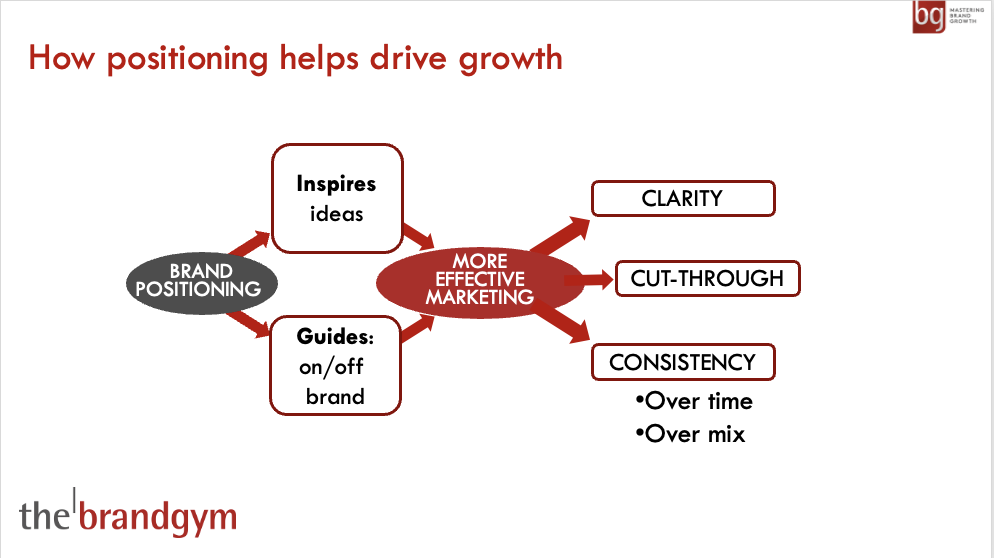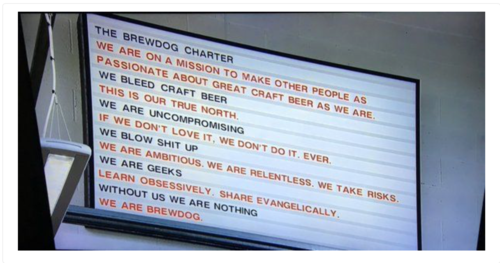The world of marketing has changed dramatically in recent years. But brand positioning is still key for effective marketing according to 91% of marketing directors in our brandgym research. However, brand positioning can fall into the trap of being an overly complex process that gets bogged down in box filling. In this post, I share some tips on how to make your approach to brand positioning as effective as possible.
Tip 1: Keep the end in mind
Keep in mind that brand positioning should be a practical process, focused on enabling more effective marketing that creates clarity, consistency and cut-through. Done well, brand positioning can help do this in two ways:
- Inspiring ideas: a clear, sharp and visualised brand positioning acts as a catalyst for marketing ideas. A recent example I posted on is the WD-40 brand of multi-purpose lubricant. The brand positioning is summed up with the idea Get the Job Done Well. The brand positioning has inspired multiple marketing programs, including the global Repair Challenge activation program I posted on here.
- Guides what is on/off brand: a brand positioning should also keep you on track, a bit like a GPS navigation system on a car. We helped the BN brand team create a brand positioning that was rooted back in the core smiley biscuit enjoyed by kids during the 4pm “gouter” in France. The positioning was summed up with the brand idea of Taste the Smile. The positioning helped clarify that teen-focused biscuits without the smile were off strategy and diluted the brand equity.

Tip 2: Focus on “photography”, not “the camera”
Companies can get too focused on the tool they use for brand positioning. I saw this firsthand in a recent brand coaching session with a global food company, sharing feedback on on a new brand positioning process. The proposed tool was complex, with multiple boxes and training needed to help people fill them all out. Using the analogy of photography, the team was focusing too much on the camera (buttons, dials, settings etc.) and not enough on how to take great photographs (choosing a subject, framing, lighting etc.).
In the case of brand positioning, the tool helps “bottle the magic” of your brand. But the key to success is the process that comes before this, which should include:
- Ambition setting: clarifying the brand and business goals
- Brand & business review: thorough analysis of existing data and research
- Fresh insight “fuel”: exploring the consumer, brand, competition and culture to create
- Idea creation and visualisation: creating and bringing to life different positioning directions
- Exploration: of the different routes
- Finalisation: defining the strongest positioning, using the learning
- Crafting: sharpening and simplifying the conent
- Action planning: working on ideas to bring the positioning to life
Tip 3: Pick any shape you want!
Over the years we’ve seen all sorts of shapes of positioning tools: brand key, brand pyramid, brand bridge. In reality, they are all pretty similar. Pick any shape you want and focus on the CONTENT. Any brand positioning tool should answer a series of key questions including:
- Core target audience
- Insight
- Brand truths (also called Reasons to believe or Functional attribute)
- Benefits
- Brand personality (also called Tone of Voice)
- Brand idea (also called Brand Essence)
- Brand purpose
Tip 4: Less is more
Many if not most brand positioning tools I see on projects are way too wordy. This makes the tool hard to use, as people using it don’t know what to focus on. So, once a draft positioning tool has been created, get one or two people to review it and strip away superfluous words. In particular, avoid duplication between different parts of the positioning, such as Brand truths (Reasons to Believe) and Benefits.
Tip 5: Avoid “pyramid polishing”
Teams can help you create positioning ideas to explore. They can also share feedback on a draft brand positioning when you get the the finalisation stage. However, avoid asking a team to work on the final wording of a brand positioning. This can lead to the problem of “pyramid polishing”, where days, weeks or months are wasted debating minor differences in wording. Crafting of a brand positioning is best done by a small team of two to three people, rather than a committee.
Tip 6: Sell the cake, not the recipe
When ordering a cake, you care about how it looks and tastes, not the recipe used to make it. And the same goes for brands. The brand positioning tool, whatever the shape, is the “recipe” for your brand. And the recipe is too complex to share with the broader business team. Rather, you need to sell “the cake” of your brand by bringing the positioning to life with visuals, sounds and best of all, examples from the current or planned future mix.
For example, the Verkade brand of chocolate and biscuits defined a positioning summed up with idea of The Taste of Home. During the project, the team created activation ideas in parallel with positioning ideas, to help bring them to life. One such idea was a seasonal house-shaped chocolate, to be sold at Christmas time to raise money for a charity helping children who have suffered abuse or neglect. This brilliantly brought to life the brand positioning. It went on to be launched in market (see below).

Tip 7: Write a brand manifesto
Writing a more long-hand manifesto, like the one from Brewdog below, allows you freedom to really express your brand positioning. It becomes more of a story, with sense of drama and emotion, rather than a list of words. To work on a manifesto in a workshop we ask a series of questions, such as “What do you fight for?” and “What do you fight against?” These sorts of questions tend to be more effective than directly asking a team, “What are your values?” It taps into how a brand team feel about their business more than what they think about it.

Tip 8: Take the positioning for a test drive
Have a “drop-deadline” when you stop working on fine tuning the positioning. Once it is 80-85% right, take it for “a test drive” by using it with your team and agency partners. Agree not to change the wording for at least six months, ideally a year. After this time, share learning on what is working and what can be improved. Make one set of changes and then go back into action mode.
In conclusion, done well, brand positioning can play a central role in inspiring and guiding brand growth. Focus on the content, not the shape of the tool. Use a team for idea generation but one to two people to craft something simple and compelling. Bringing the positioning to life and then move into action mode, avoiding the perils of “pyramid” polishing!
